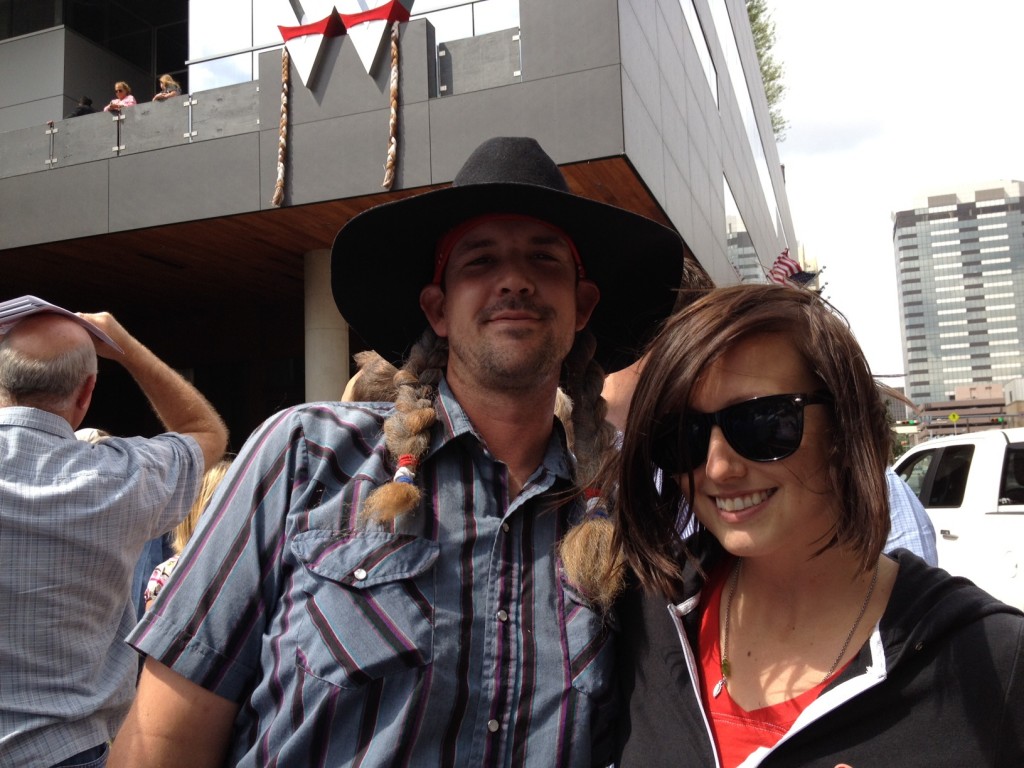On Thursday night, I arrived in Austin to attend the 13th annual International Symposium on Journalism, at the University of Texas. A couple of hours earlier, the college of communication named a cactus-and-concrete plaza after Walter Cronkite, who spent a couple of years there on his way to becoming the most trusted man in America, and premiered “All the News That’s Fit to Print,” a projection by my neighbor Ben Rubin. At the four corners of the plaza, plaques extol four virtues he embodied: Accuracy, Courage, Independence, and Integrity. Each plaque has a bas-relief of Cronkite and a paragraph of commentary. On the Integrity plaque, for example, it says. “Walter Cronkite held firm to a strict code of moral values.”
On Friday afternoon, after my panel on the mobile revolution, I headed down to the corner of Second and Lavaca for the unveiling of a statue of Willie Nelson, who came to Austin forty years ago. Through a diaphanous khaki tarp, all you make out was the neck of the guitar.
Both Second (now known as Willie Nelson Boulevard) and Lavaca were closed to traffic, and two vehicles parked in the middle of Lavaca: a flatbed truck to give camera crews a better view, and an blue-and-red Airstream with Shiner Bock, Tito’s Handmade Vodka, and other refreshments for working press.
Katherine Stolp, the weekend anchor for Austin’s CBS affiliate, was on hand to cover the ceremony, which was streamed live on the KEYE Web site and would lead the 6 p.m. news. She hadn’t covered the Cronkite event, but KEYE had. When asked who she admired more, the anchorman or the outlaw country-music pioneer, Stolp at first said Cronkite, but then said, “It’s really a toss-up.” Cronkite, she said, “was always genuine. You felt like could believe him. Kind of like I feel about Willie Nelson when I watch him.”
Josh McHenry and Allyson Stephens took the day off—she’s the assistant manager at an apartment complex, he does maintenance—to attend the unveiling. “I was supposed to be in California today, but this took precedence,” added McHenry, who wore a red bandana and a pair of yarn braids, in tribute to his musical idol.
So did Eddy Wilson, who is almost four months old, according to Kacie Case, who was wearing Eddy, facing inward, in a sling.
Even the sans-serif W of Austin’s new W hotel, which is right next to the statue, dressed for the occasion.
The ceremony was scheduled for 4:20 pm on April 20th—a numerologically significant moment for Nelson and other supporters of legalizing marijuana. It began a few minutes after four, and the emcee introduced Lawrence Wright, the president of Capital Area Statues, Inc., the nonprofit organization which raised the money for the statue, its third. (Read about the first and second.)
Then Mayor Lee Leffingwell took the podium. As he thanked various municipal officials, three guys upwind of me started passing around joints. (Can you imagine Mayor Bloomberg helping a weed-friendly crowd to canonize one of their idols on their high holiday?) To the right, someone looked at his phone and noticed that it was already 4:22. “They blew it on the timing,” he grumbled. “Maybe they got stoned earlier.”
At 4:27, the khaki tarp was removed, and the crowd cheered. Willie Nelson looked at the larger than life bronze of himself. He felt the smiling statue’s arm, then the guitar neck. He posed for a photograph with the sculptor, Clete Shields. Nelson thanked the Austin, then said, “While I’ve got this guitar…” and the whooping crowd drowned out the rest of his sentence. He sang “On the Road Again,” with help from the audience, then “Roll Me Up and Smoke Me When I Die” before slowly making his way to the pastel-painted tour bus with indian chief on the side.
He sang both songs again on Saturday night at the Backyard, out in Bee Cave, plus a whole lot more—but not my favorite, “Sad Songs and Waltzes.”




